Cheap Tech Review: The €30 Amazfit Stratos 3 homage
Smart watches, as a form of wearable computer strapped to the wrist, have come a long way since the early days of the Fossil Wrist PDA, Microsoft SPOT and Pebble. The first iteration of Apple Watch and Google Wear launched in 2014 with the ambition of putting a computer around everybody's wrist and, seven years later, they could not be further away: while the former has achieved a dominating market share, the latter lingered in limbo for several years without solid hardware and software upgrades. Because of that, many third-party manufacturers have successfully carved a niche in the void left by Google and seized the market opportunity of a low-cost alternative.
The Apple Watch meanwhile has reached its seventh iteration as a market benchmark; with a starting price (in Europe) of €300 it also comes with a hefty price tag, shared with the latest and greatest Ticwatch Pro 3 Ultra GPS from Mobvoi which promises an endless list of sensors for health monitoring and fitness tracking capabilities. If all the same features were available in a device that costs ten times less, how much of a compromise would that be?
Unpacking and unboxing
The subject of this review is the Melanda MD15 smartwatch, which can be purchased on AliExpress for €32 including delivery. The same device can also be found under other brands (such as Lemfo and Sanlepus) and a quick internet search reveals they all are a repackaging of the well known L15 model, manufactured by Chinese firm MicroWear.
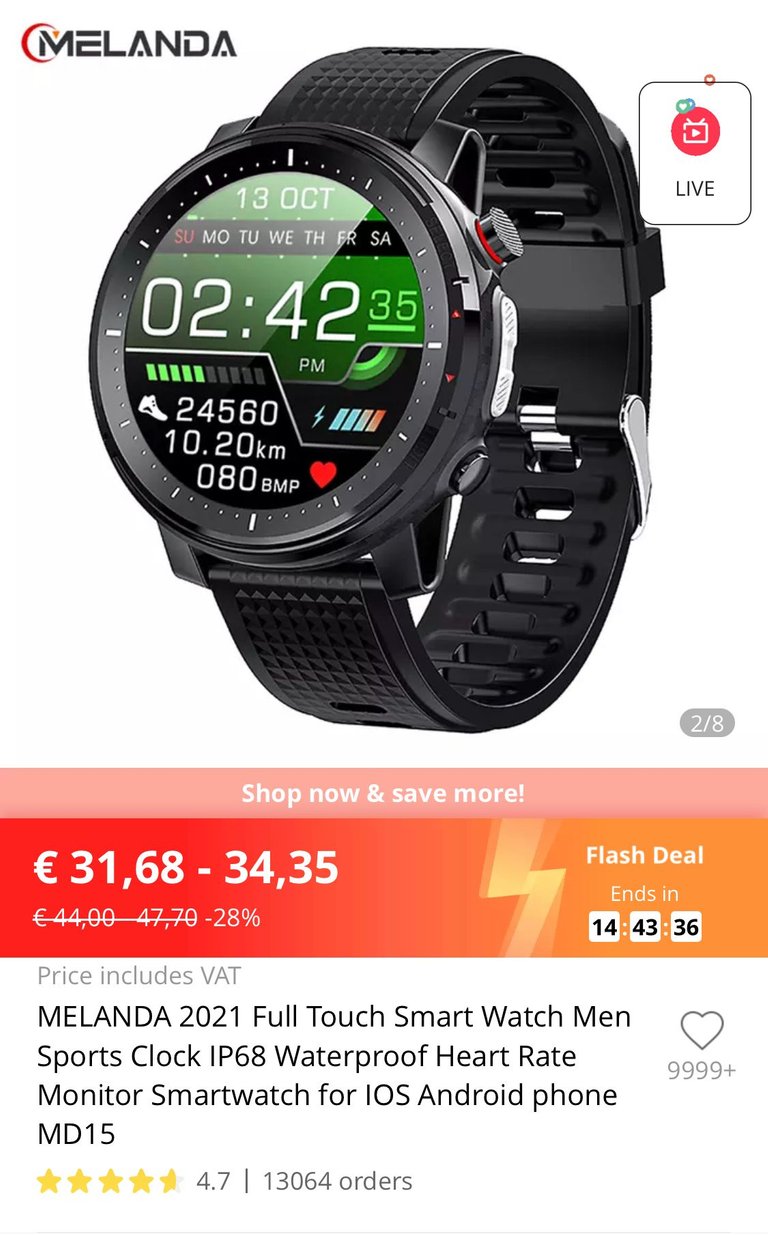
From a quick glance, its design is obviously a homage to the Amazfit Stratos 3 for one-sixth of the price.
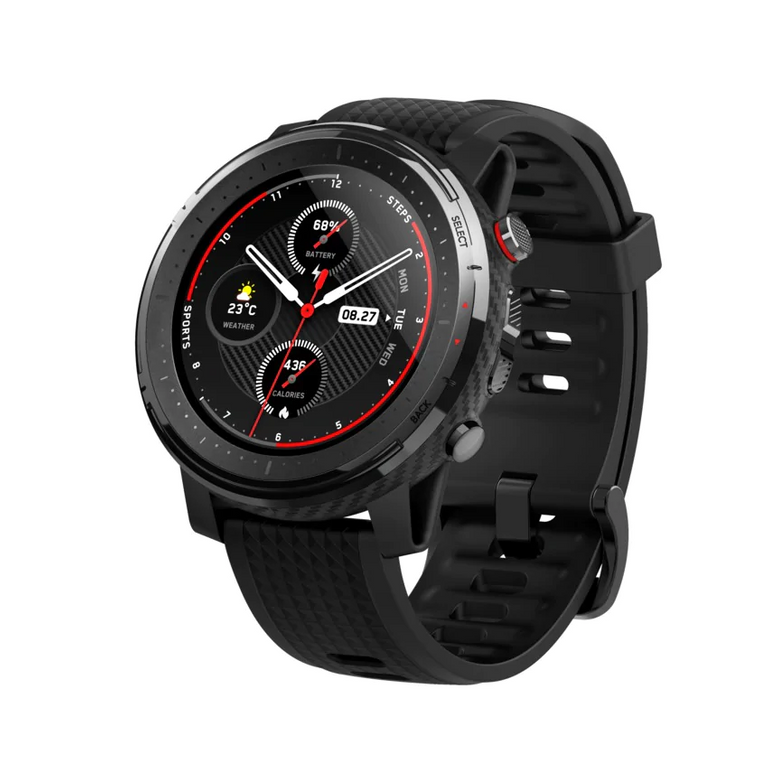
The smartwatch was delivered in a solid, if unassuming, black textured cardboard package sporting a mirror finished "Smart Wear" red printing. Inside the box a thin plastic mold is holding the watch in place, with the USB-A charging cable and user manual (in Chinese and badly translated English) tucked underneath. The packaging does its job, but it looks and feels pretty low-budget.
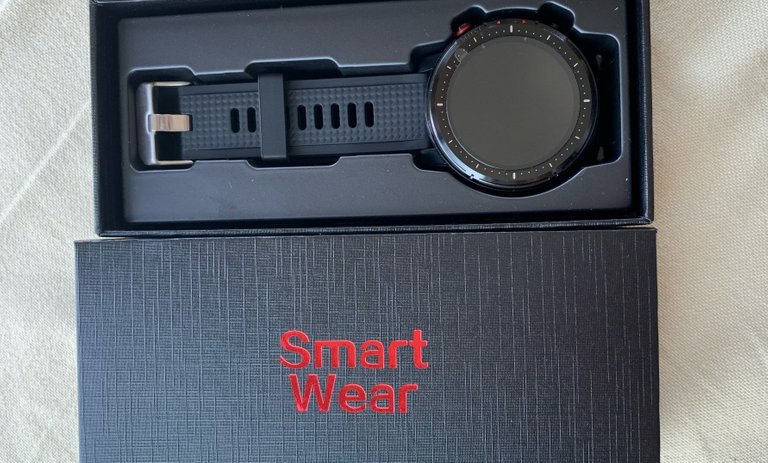
Design and materials
The MD15, exactly like the Stratos 3, sports a black round plastic case with a "carbon fiber look" texture. Far from fooling anyone, this finishing gives the watch a (subjectively) nicer look than plain matte black or the majority of fake materials that are commonplace for this category; remains to be seen how it will withstand normal use and abuse, as this kind of textured surfaces are easily prone to scuffing and scratching.
The circular IPS display is covered with a mineral glass which, while not providing the same level of scratch resistance as sapphire glass, is pleasant when interacting with the touch screen; however it does not feature any oleophobic coating, which makes it a smudge magnet and betrays its budget nature. The surrounding bezel is made of a metallic alloy that provides a better look and feel than plastic and features a basic printed chapter ring; that serves no purpose other than decoration, even though it blends nicely when analog watch faces are used.
The watch comes with a diamond-textured black silicone strap that latches with a brushed metal buckle; it is simple but functional and fits the style well. The bracelet has a free loop adjustment holes for all of its lenght and makes very simple to find a proper fit for any wrist size; the material is soft to the touch but properly flexible, and does not feel flimsy or cheap in any way.
On top of that there are quick release pins that allow for a very easy replacement with any standard 22mm band. All things considered, the strap looks and feels much better than expected and makes the watch extremely comfortable to wear despite its large 46mm size.
On the case back there are the optical sensors protected behind a transparent plastic lens and a two-pin charging port.
The side of the case body hosts two pushers: the top one, which gets a color accent thanks to a red gasket, is the main selector; the bottom one has the only purpose to turn on and off a twin-LED cluster which is, very unusually, installed on the side of the watch. This LED can be used as a torch and represent quite a unique and useful feature of the MD15.
Case back and user manual boast an IP68 water and dust resistance but, as usual for devices in this class, it is not recommendable to put these claims to the test. Based on materials and design, this smartwatch can likely withstand accidental contact with water (such as rain and hands washing) but it's safer to avoid submerging it.
Setup and mobile app experience
The initial setup and pairing requires to download and install the FitCloud Pro app (available for iOS and Android). The procedure is straightforward and well detailed both in the app and the small printed manual provided with the watch. After pairing, the watch keeps synchronizing key fitness data to the app without user intervention (even though it is always possible to trigger a full manual sync from the app).
The FitCloud Pro app (tested on iPhone) has a fairly plain UI dominated by orange tones; it will not win any design award but, in its simplicity, it manages to deliver all the watch management functions and present health and activity data on a clear dashboard through a three-panel structure.
Home is the front page health dashboard, which includes current day values for steps, calories, distance, and steps goal. Additional panels (which can be tapped to show detailed graphs for each metric, and then further drill down through historic data) provide information about sleep, heart rate, ECG, blood pressure and blood oxygen. The MD15 is capable of measuring a surprising range of vital signs, including some that are usually reserved to expensive top-of-the-line health tracking devices.
The Device tab contains the smartwatch settings and control panel. Available options include configuring push notifications from the phone, setting alarms, enabling periodic activity and drink reminders, choose the watch face among the available collection, enable raise-to-wake and an elevated heart rate warning, configure a time range for health monitoring, activate a locator function that makes the watch buzz remotely, choose wearing wrist, and 12/24H time format. These include several useful features and are globally sorted in a useful, user-friendly way.
The Me tab is mostly about the user profile (which the app allows to create at first run) that is used to collect all data in the cloud. A few additional items allow to set the daily "sports goal" for steps, distance and calories, switch between metric and imperial units, enable/disable Apple Health or Google Fit integration, and some basic management functions such as a feedback form.
Despite some quirky visual details, such as the bouncing effect when a graph plotting animation reaches a frame border and a pervasive use of the color orange, the application is very well designed and offers a lot of functionality while presenting all the data in an accessible, easy to understand format.
User interface
Immediately after boot, interacting with the touch screen makes apparent that the MD15 user interface is taking a lot of inspiration from Google WearOS 2.
Swiping left from the watch face there is a scrolling menu, whose actions include locate the paired phone (by making it buzz), a stopwatch, a timer, display the device QR code (for pairing purposes), an About screen, perform a factory reset and shut down the smartwatch. Critical actions such as factory reset and shutdown require confirmation from the user.
Swiping right reveals a sequence of information screens whose design closely resembles basic Wear OS tiles: in sequence there are Steps (including km and calories), Sleep (with summary of total sleep time, and detail of deep and light sleep time), a four-button panel that provides quick access to start a health tracking monitor on-demand (heart rate, blood pressure, blood oxygen level and ECG), fitness tracking (with an extended list of activities), a media control screen (that will remotely control whatever media is playing on the phone, if any) and the Weather screen (which includes temperature, forecast, rain chance and a fairly obscure indicator whose icon may or may not represent air quality). While being practical and useful, the MD15 "tiles" - unlike Wear OS - are fixed and cannot be rearranged or deactivated; they also don't expand vertically to provide more information.
Swiping down opens the notification stack, which shows all the notifications received from the phone; they include an icon representing the app, and the text content. Each notification can be dismissed by tapping the screen, and longer notifications are spanning over more screens.
Finally, swiping up gives access to a basic settings page whose actions include display the QR code, the About screen, the phone locator (all of them for some reason duplicating the same functions present in the side menu), the battery level, and the display brightness selector. A small panel at the bottom of the screen contains date, time and state of the wireless link between watch and phone.
Tapping and holding on the main screen will summon a watchface selector, exactly like WearOS, which scrolls between the faces currently loaded on the watch.
User experience
The MD15 will immediately feel familiar to anyone who has used a WearOS device. All functions are within reach and, thanks to the relatively small number of options, easy to find and manage.
The UI is simple but functional and, most importantly, it is always responsive. The MD15 runs a proprietary OS and is not burdened by Google Wear's hardware requirements, which enables it to maintain a very respectable level of performance.
Speaking of, an element that will be immediately evident even to the less tech-savvy user is the boot time: unlike any wearable running on the aforementioned WearOS, the MD15 starts from power-off in a matter of seconds. This is much faster than any Google-powered smartwatch and most certainly due to its barebone proprietary operating system.
Health and sleep tracking
After setup, automatic health tracking works well and logs a remarkable amount of data that is available in real-time through the app dashboard. Basic parameter tracking is accurate and provides results comparable to a Fitbit wristband. The latter though remains unsurpassed in sleep monitoring thanks to its very precise REM sleep detection, unavailable on the MD15 which only reports light and deep sleep states. However, except this difference, the side-by-side comparison shows results from the two devices are pretty much identical - which is a remarkable result as the MD15 is much more affordable than a Fitbit.
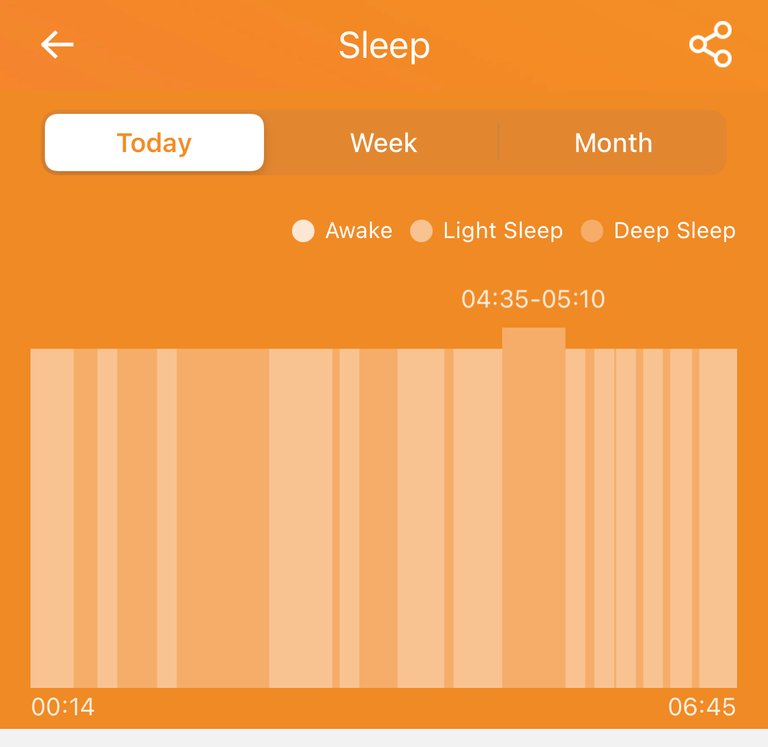 |  |
|---|
Compared to most Fitbits however, the MD15 is a chunky device that could hardly make one forget about its presence on the wrist. Albeit sporting a thin profile, its 46mm case and substantial lug-to-lug measure may be uncomfortable to wear during sleep.
If that is not an issue, the robust battery life provides an ideal companion for several nights of sleep tracking between charges.
Fitness tracking
Unlike with more advanced (and expensive) devices, there is no automatic activity detection: starting a session is a strictly manual affair. On the upside, this only requires four swipes from the main screen through the UI tiles and provides a surprisingly comprehensive list. While not getting even remotely close to the hundreds of different activities tracked by a Garmin, the available ten modes are covering all the basics and include some less usual ones (such as yoga). The user is also required to manually stop a session, which will then trigger all relevant data to be uploaded to the mobile app for display. Vital signs are tracked by the optical sensors and provide a wealth of data that can be effectively used to track and assess workouts and training.
The watch does not include a GPS unit, but it will use GPS data provided through the app by a paired mobile phone.
On-demand measurement
Three swipes from the main screen bring up the on-demand measurement menu. From here, one can manually start a monitoring session for all the four key vital parameters supported by the smartwatch: heart rate, blood pressure, blood oxygen level and ECG. These are measured at regular intervals of a few minutes when the Continuous Health Monitoring is enabled, but starting an on-demand session triggers a higher frequency monitoring that (allegedly) provides more accurate results.
The ECG function is also fairly unique as it's not commonly found in fitness trackers - with a few notable exceptions that belong to a much higher price range. Starting an ECG session even generates a detailed report in the mobile app that can be exported as PDF, in a format that closely mimics a paper roll polygraph.
Another feature that is even more rare in fitness trackers is on-demand blood pressure monitoring. This is available from the same menu and delivers a graphic output in the mobile app.
While the accuracy of measurement provided by the optical sensor may be debatable (especially for blood pressure) and it is very important not to consider these values as relevant for any medical or diagnostic purpose, these features are nonetheless well integrated and nice to have in a device at this price point.
Notifications
Swiping down from the main screen opens the notification stack. Its implementation, albeit functional, is one of the details that betrays the ultra-budget nature of the MD15 software. Notifications are written with a basic typeface and suffer from poor hinting and kerning, which makes them look cheap and compromise readability; longer blocks of texts are split between multiple screens that require tapping to proceed and are immediately deleted afterwards, making impossible to read back at a later time; oftentimes (especially with e-mail headers) they are riddled with exclamation marks and other randomly added punctuation signs; and, worse of all, the notification engine does not seem capable of splitting words correctly, which gives an unacceptable reading experience.
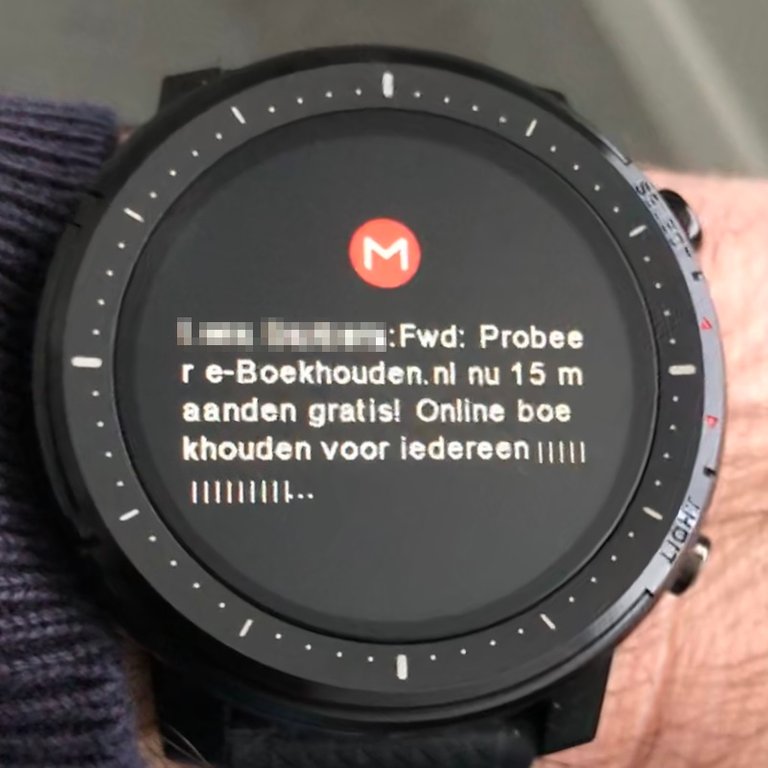 | 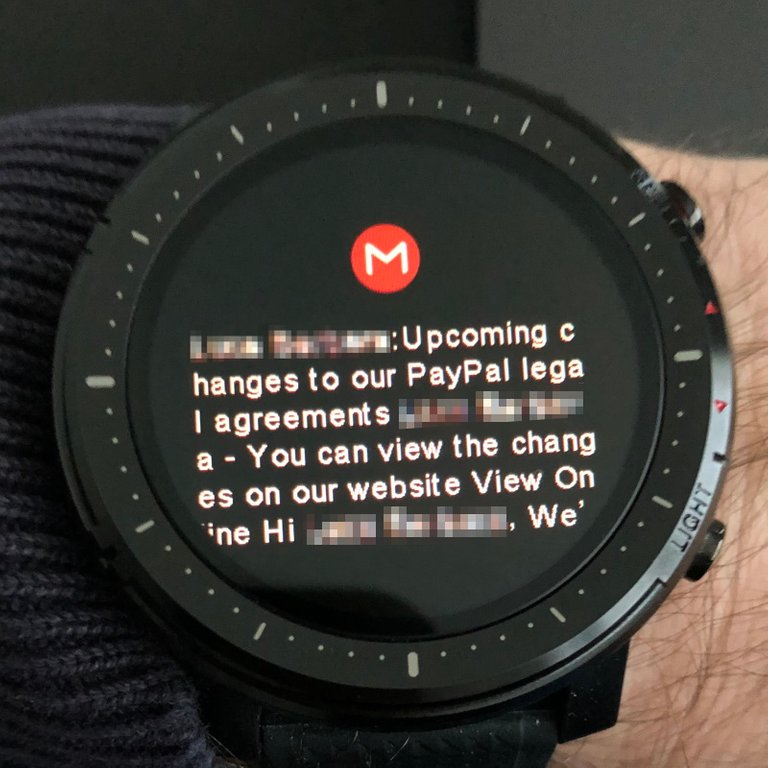 |
|---|
On top of that, only notifications from supported apps (configured and enabled in the mobile app) are forwarded to the watch; while this list includes some of the most popular, notifications from any other app will be ignored. This includes every internal iPhone notification and dozens of others that will never work.
To make things even worse, the watch will hold only 5 (five) notifications at any given time: from the 6th onwards, they will not be selectable for reading or display.
The watch also does not have an automatic or manual Do Not Disturb mode that silences notifications, and most crucially it will not honor the paired mobile's DND mode. Because of that, receiving notifications will keep the watch buzzing and activating the display when it should not, including at night and while sleeping: the only way to prevent this behaviour is to turn it off completely.
Haptic feedback
The watch is equipped with a good haptic engine that has proven surprisingly capable: each notification is followed by a distinct vibration that will not go unnoticed on the wrist. In fact, the engine is perhaps too strong, to the point that any incoming notification also delivers a very audible high-pitched whine that can and will be heard in close proximity. As feedback intensity is not configurable, this will result in a pretty loud experience: people who are sensitive to noises can find it quite unpleasant.
Watchfaces
The MD15 default watch face is a fitness-oriented, information-rich digital display that shows date, time, day of the week, watch battery status, and health statistics. In alternative it is possible to choose other watch faces from a dedicated menu in the mobile app. This closely resembles the corresponding Google Wear app menu and offers a fixed selection of designs. These include analog and digital faces with some variety in terms of color and style, and there also are some fairly recognizable dials that are clearly "inspired" by more famous products: among them an Apple Watch-like face, several Mobvoi Ticwatch models, obviously the default Amazfit Stratos 3 analog-hybrid design, and a Garmin-inspired dial.
It is worth noting how most dials feature a similar flat design with precious little nothing more than time and date; when complications are present (like in the Stratos 3-like watch face) most elements are static decorations designed to look like the real thing. The Garmin-inspired dial was possibly the best in terms of readability and detail, but before the end of the review period it has been removed from the "watchface store"; other "inspired" designs (such as the "Apple Watch" clone) have suffered the same fate and are not available anymore.
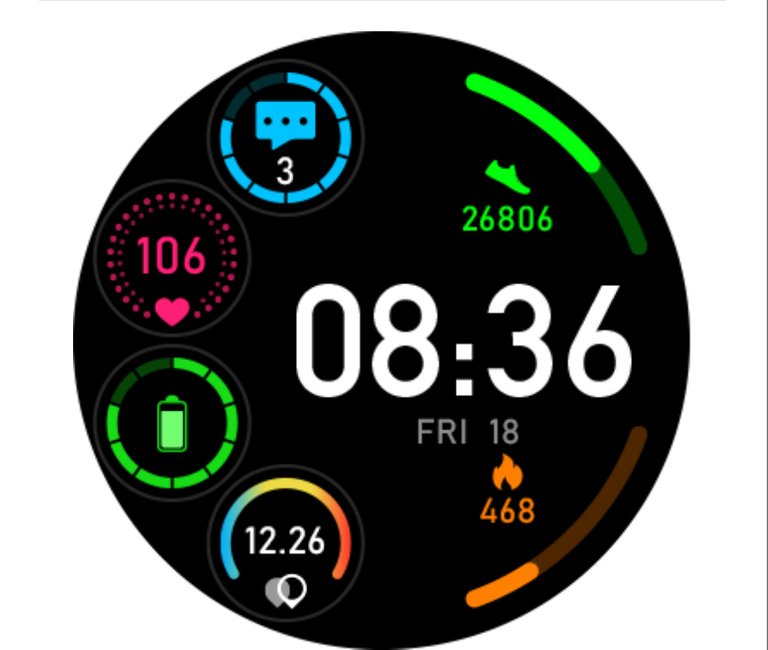
The watchface menu includes a "builder" widget where it is possible to design a dial, but the options are limited to customizing the background and time/date position. Other than that, there is no way to load custom or 3rd party faces to the watch. While this limitation is understandable for a budget product and certain faces have likely been removed to avoid infringing copyright, it was nonetheless disappointing to see the most functional and attractive styles disappear.
Display
The MD15 features a 1.3" touch-screen IPS display with a resolution of 360x360 pixel. The screen is crisp and has vibrant, rich colors that allow for a good readability in all conditions; it also provides a sharp rendering of all the provided watch faces, which is unusual at this price point. There is no ambient light sensor and brightness must be manually set among five levels, but the display is readable in broad daylight. The touchscreen action is consistent and well defined, with a minimal lag that makes the watch comfortable to use and operate. Taps and swipes work correctly and without hesitation.
The display vastly exceeds expectations and represents one of the best features of the watch.
However, unlike many of its brand-name counterparts that provided so much design inspiration, the MD15 does not have an always-on display: as that is done to save battery, in order to read time and date one must flick the wrist for the screen to turn on. The watch will correctly register the gesture and activate most of the times, but that doesn't really compensate for a display that is always visible at glance.
Battery life
The watch comes equipped with a 370mAh rechargeable battery which is declared good for 7-10 days of usage. This is confirmed across four months of testing where the watch has been able to deliver up to 15 days of operation with all features enabled, but without tracking fitness activities. The USB charging cable connects to a polarized magnetic port on the case back and, once in place, it keeps a strong latch; a full charge using a standard 5V/1A power supply can take more than three hours, but partial charges are quicker.
Given the long autonomy of the battery, it is possible to keep the watch running 24/7 and using it as sleep tracker by charging it for 10 minutes every day (for instance while taking a shower).
Conclusions
This smartwatch has a lot of potential: it can be surprising and excel in some unexpected areas, and then be disappointing with other (more common) features. For instance, glancing down at the screen will always provide a pleasant experience thanks to its vibrant colors and sharp resolution; but that will also be a constant reminder of the missing always-on display, requiring a wrist flick to read time and date. Notifications will be reliably available and Bluetooth connectivity has been flawless through several weeks of testing; but the experience is ruined by poor lettering, broken line splitting, and the (frankly absurd) stack size limit of 5 notifications. And, if left on the bedside, the watch will keep buzzing and lighting up as notifications are coming through during the night.
For a price (at the time of writing) of EUR 33 on AliExpress, the MD15 delivers some quite unique features, it is a well-built and good looking device, and it is far from the worst especially at its price point. That said, one must be aware of its peculiarities and seriously evaluate all pros and cons before purchasing.
Disclosure: this review is not sponsored by the product manufacturer, there are no affiliate links, and the seller did not receive a copy before publication. All items under review are directly purchased at retail price, and evaluated accordingly.